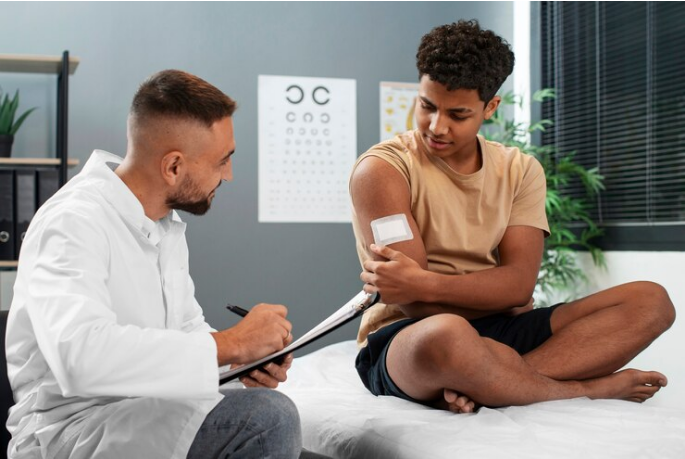Testosterone Replacement Therapy (TRT) has gained significant attention as a treatment for low testosterone levels, particularly among men experiencing symptoms related to aging, chronic illness, or other medical conditions.
Low testosterone, or hypogonadism, can cause symptoms such as fatigue, mood swings, decreased libido, muscle weakness, and difficulty in maintaining muscle mass. To help alleviate these symptoms, testosterone replacement therapy aims to restore testosterone to healthy levels.
1. Injectable Testosterone
(A) Intramuscular Injections
Injectable testosterone is one of the most common forms of TRT. Typically, testosterone is administered intramuscularly, meaning it is injected directly into a muscle, often in the thigh or buttock. The two primary types of injectable testosterone include:
- Testosterone Cypionate: This form of testosterone is long-acting, usually administered every one to two weeks. It is preferred for its affordability and long duration of action.
- Testosterone Enanthate: Similar to cypionate, enanthate is also a long-acting form of testosterone, given every one to two weeks, depending on individual needs.
Injectable testosterone tends to have a more rapid onset than some other forms, and since it's administered at regular intervals, it allows for more predictable control over hormone levels.
(B) Subcutaneous Injections
Subcutaneous injections are another option, where testosterone is injected into the fat layer beneath the skin. This method is less invasive than intramuscular injections but may result in fewer side effects. Subcutaneous injections are generally administered once per week and offer more steady hormone levels without the peaks and valleys that intramuscular injections may cause.
Pros and Cons of Injectable Testosterone
- Pros:
- Fast onset of action
- Longer intervals between doses (especially with intramuscular injections)
- Relatively inexpensive
- Cons:
- Injection site discomfort or pain
- Potential for fluctuating hormone levels (especially with intramuscular injections)
- Requires self-administration or regular doctor visits
2. Topical Testosterone
Topical testosterone comes in the form of gels, creams, and patches, which are applied to the skin, allowing the hormone to be absorbed into the bloodstream. Popular brands include AndroGel, Testim, and Axiron. Topical testosterone is applied daily, and the dosage is easily adjustable based on the patient’s response to treatment.
(A) Testosterone Gels and Creams
Gels and creams are applied to specific areas of the body, usually the shoulders, upper arms, or abdomen. The testosterone hormone is absorbed through the skin into the bloodstream. One of the primary benefits of this form of therapy is its ease of use and the ability to adjust doses quickly.
(B) Testosterone Patches
Patches are another form of topical testosterone and are worn on the skin. They release testosterone over a 24-hour period, ensuring a more consistent hormone level. The patch is typically applied to the back, stomach, thighs, or upper arms.
Pros and Cons of Topical Testosterone
- Pros:
- Non-invasive and easy-to-use
- Steady release of testosterone, avoiding large fluctuations
- Adjustable dosage
- Cons:
- Skin irritation at the application site
- Potential for accidental transfer to others (such as children or partners)
- Requires daily application
- Higher cost compared to injectable forms
3. Testosterone Pellets
Testosterone pellets are a longer-lasting form of testosterone therapy, where small pellets containing the hormone are implanted under the skin, usually in the buttocks. The pellets slowly release testosterone into the bloodstream over the course of three to six months. This method offers a "set it and forget it" approach, as the patient does not need to administer the therapy on a regular basis like with injections or topical forms.
Pellet therapy can be a great option for individuals who prefer not to worry about frequent treatments. However, the procedure requires a minor surgical procedure for insertion and removal, and there may be some discomfort or infection risk at the insertion site.
Pros and Cons of Testosterone Pellets
- Pros:
- Long-lasting and low-maintenance
- Steady and consistent release of testosterone over several months
- Cons:
- Requires minor surgical procedure for implantation
- Infections or pellet rejection may occur
- Difficult to adjust dosage once implanted
4. Testosterone Buccal Tablets
Buccal tablets, such as Striant, are placed between the upper gums and the cheek. The testosterone is absorbed through the mucous membranes of the mouth into the bloodstream. This method is generally used twice daily and provides a consistent release of testosterone.
While buccal tablets may be a less common form of TRT, they do offer an alternative for individuals who cannot use injections or topical applications.
Pros and Cons of Buccal Testosterone
- Pros:
- Non-invasive and easy to administer
- Consistent release of testosterone
- Cons:
- Can cause gum irritation or discomfort
- Requires twice-daily application
- Less common, so fewer doctors may be experienced with this method
5. Oral Testosterone
Oral testosterone therapy is less commonly prescribed due to potential liver toxicity risks, but newer formulations like testosterone undecanoate have made it possible to administer testosterone orally in a safer way. These are absorbed via the lymphatic system, bypassing the liver to avoid the potential for damage.
Pros and Cons of Oral Testosterone
- Pros:
- Convenient to take as a pill
- Non-invasive
- Cons:
- Potential liver impact with certain formulations
- Less consistent testosterone levels compared to other methods
- Requires frequent dosing
Choosing the Right Testosterone Replacement Therapy
The best type of testosterone replacement therapy depends on various factors, including the patient's lifestyle, preference, medical history, and how their body responds to different forms of testosterone.
If you are unsure about which type of TRT will work for you, contact the team of Connected Care NP for personalized TRT therapy in Iowa. You can directly talk with a trusted and certified healthcare professional to create a custom approach for you. Book a free consultation today!





Comments